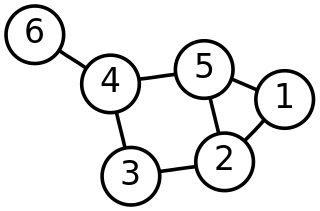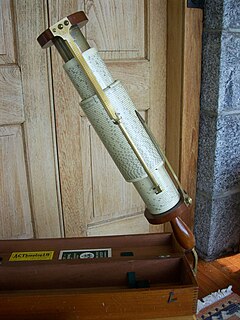
Discrete mathematics is the study of mathematical structures that can be considered "discrete" rather than "continuous". Objects studied in discrete mathematics include integers, graphs, and statements in logic. By contrast, discrete mathematics excludes topics in "continuous mathematics" such as real numbers, calculus or Euclidean geometry. Discrete objects can often be enumerated by integers; more formally, discrete mathematics has been characterized as the branch of mathematics dealing with countable sets. However, there is no exact definition of the term "discrete mathematics".
In mathematics, the factorial of a non-negative integer , denoted by , is the product of all positive integers less than or equal to . The factorial of also equals the product of with the next smaller factorial:

In mathematics, the logarithm is the inverse function to exponentiation. That means the logarithm of a given number x is the exponent to which another fixed number, the base b, must be raised, to produce that number x. In the simplest case, the logarithm counts the number of occurrences of the same factor in repeated multiplication; e.g. since 1000 = 10 × 10 × 10 = 103, the "logarithm base 10" of 1000 is 3, or log10 (1000) = 3. The logarithm of x to base b is denoted as logb (x), or without parentheses, logb x, or even without the explicit base, log x, when no confusion is possible, or when the base does not matter such as in big O notation.
An order of magnitude is an approximation of the logarithm of a value relative to some contextually understood reference value, usually 10, interpreted as the base of the logarithm and the representative of values of magnitude one. Logarithmic distributions are common in nature and considering the order of magnitude of values sampled from such a distribution can be more intuitive. When the reference value is 10, the order of magnitude can be understood as the number of digits in the base-10 representation of the value. Similarly, if the reference value is one of some powers of 2, since computers store data in a binary format, the magnitude can be understood in terms of the amount of computer memory needed to store that value.

The slide rule is a mechanical analog computer, which is used primarily for multiplication and division, and for functions such as exponents, roots, logarithms, and trigonometry. It is not typically designed for addition or subtraction, which is usually performed using other methods. Maximum accuracy for standard linear slide rules is about three decimal significant digits, while scientific notation is used to keep track of the order of magnitude of results.

A logarithmic scale is a way of displaying numerical data over a very wide range of values in a compact way—typically the largest numbers in the data are hundreds or even thousands of times larger than the smallest numbers. Such a scale is nonlinear: the numbers 10 and 20, and 60 and 70, are not the same distance apart on a log scale. Rather, the numbers 10 and 100, and 60 and 600 are equally spaced. Thus moving a unit of distance along the scale means the number has been multiplied by 10. Often exponential growth curves are displayed on a log scale, otherwise they would increase too quickly to fit within a small graph. Another way to think about it is that the number of digits of the data grows at a constant rate. For example, the numbers 10, 100, 1000, and 10000 are equally spaced on a log scale, because their numbers of digits is going up by 1 each time: 2, 3, 4, and 5 digits. In this way, adding two digits multiplies the quantity measured on the log scale by a factor of 100.

In mathematics, the common logarithm is the logarithm with base 10. It is also known as the decadic logarithm and as the decimal logarithm, named after its base, or Briggsian logarithm, after Henry Briggs, an English mathematician who pioneered its use, as well as standard logarithm. Historically, it was known as logarithmus decimalis or logarithmus decadis. It is indicated by log(x), log10 (x), or sometimes Log(x) with a capital L. On calculators, it is printed as "log", but mathematicians usually mean natural logarithm rather than common logarithm when they write "log". To mitigate this ambiguity, the ISO 80000 specification recommends that log10 (x) should be written lg(x), and loge (x) should be ln(x).
In mathematics, for given real numbers a and b, the logarithm logb a is a number x such that bx = a. Analogously, in any group G, powers bk can be defined for all integers k, and the discrete logarithm logb a is an integer k such that bk = a. In number theory, the more commonly used term is index: we can write x = indra (mod m) for rx ≡ a (mod m) if r is a primitive root of m and gcd(a,m) = 1.
Henry Briggs was an English mathematician notable for changing the original logarithms invented by John Napier into common logarithms, which are sometimes known as Briggsian logarithms in his honour. The specific algorithm for long division in modern use was introduced by Briggs c. 1600 AD.
In computer science, a one-way function is a function that is easy to compute on every input, but hard to invert given the image of a random input. Here, "easy" and "hard" are to be understood in the sense of computational complexity theory, specifically the theory of polynomial time problems. Not being one-to-one is not considered sufficient for a function to be called one-way.
This is a list of logarithm topics, by Wikipedia page. See also the list of exponential topics.

Percy Edwin Ludgate was an Irish amateur scientist who designed the second analytical engine in history.

The history of logarithms is the story of a correspondence between multiplication on the positive real numbers and addition on the real number line that was formalized in seventeenth century Europe and was widely used to simplify calculation until the advent of the digital computer. The Napierian logarithms were published first in 1614. Henry Briggs introduced common logarithms, which were easier to use. Tables of logarithms were published in many forms over four centuries. The idea of logarithms was also used to construct the slide rule, which became ubiquitous in science and engineering until the 1970s. A breakthrough generating the natural logarithm was the result of a search for an expression of area against a rectangular hyperbola, and required the assimilation of a new function into standard mathematics.
Irish logarithms were a system of number manipulation invented by Percy Ludgate for machine multiplication. The system used a combination of mechanical cams as look-up tables and mechanical addition to sum pseudo-logarithmic indices to produce partial products, which were then added to produce results. The technique is similar to Zech logarithms, but uses a system of indices original to Ludgate.

The Fuller calculator, sometimes called Fuller's cylindrical slide rule, is a cylindrical slide rule with a helical main scale taking 50 turns around the cylinder. This creates an instrument of considerable precision – it is equivalent to a traditional slide rule 25.40 metres long. It was invented in 1878 by George Fuller, professor of engineering at Queen's University Belfast, and despite its size and price it remained on the market for nearly a century because it outperformed nearly all other slide rules.

A slide rule scale is a line with graduated markings inscribed along the length of a slide rule used for mathematical calculations. The earliest such device had a single logarithmic scale scale for performing multiplication and division but soon an improved technique was developed which involved two such scales sliding alongside each other – hence the name slide rule. Later, multiple scales were provided with the most basic being logarithmic but with others graduated according to the mathematical function required.










